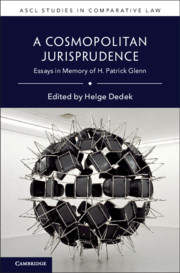Book contents
- A Cosmopolitan Jurisprudence
- ASCL Studies in Comparative Law
- A Cosmopolitan Jurisprudence
- Copyright page
- Epigraph
- Contents
- Foreword
- Acknowledgements
- Notes on Contributors
- Images
- Introduction
- Part I The Tradition of Comparative Law
- 1 How to Do Comparative Law: Some Lessons to Be Learned
- 2 The ‘Comparative Method’ at the Roots of Comparative Law
- 3 The Value of Micro-Comparison
- 4 Sociocultural Challenges for Comparative Legal Studies in Mixed Legal Systems
- 5 Breaking Barriers in Comparative Law
- Part II The Concept of Tradition
- Part III Crossing Boundaries
- H Patrick Glenn Publications
- Index
1 - How to Do Comparative Law: Some Lessons to Be Learned
from Part I - The Tradition of Comparative Law
Published online by Cambridge University Press: 10 December 2021
- A Cosmopolitan Jurisprudence
- ASCL Studies in Comparative Law
- A Cosmopolitan Jurisprudence
- Copyright page
- Epigraph
- Contents
- Foreword
- Acknowledgements
- Notes on Contributors
- Images
- Introduction
- Part I The Tradition of Comparative Law
- 1 How to Do Comparative Law: Some Lessons to Be Learned
- 2 The ‘Comparative Method’ at the Roots of Comparative Law
- 3 The Value of Micro-Comparison
- 4 Sociocultural Challenges for Comparative Legal Studies in Mixed Legal Systems
- 5 Breaking Barriers in Comparative Law
- Part II The Concept of Tradition
- Part III Crossing Boundaries
- H Patrick Glenn Publications
- Index
Summary
This Chapter appraises the range and depth of Patrick Glenn’s scholarly legacy by exploring some of the many lessons that can be drawn from his opus magnum Legal Traditions of the World. To this purpose, the chapter will focus on three key notions underlying Glenn’s chefs-d’œuvre: Law, Tradition, and Conciliation. The argument is that Glenn’s findings have in multiple ways enlightened the understanding of what the law is (outside and also inside the West), as well as the relentless dynamics within and between legal traditions. Through these findings, Glenn has also provided us – his friends, colleagues, readers – with a powerful intellectual tool to pursue his conciliatory dream towards a world of tolerance and diversity.
Keywords
- Type
- Chapter
- Information
- A Cosmopolitan Jurisprudence , pp. 29 - 43Publisher: Cambridge University PressPrint publication year: 2021
- 1
- Cited by



